| Listing 1 - 9 of 9 |
Sort by
|
Book
ISBN: 2225854424 Year: 1997 Publisher: Paris : Masson,
Abstract | Keywords | Export | Availability | Bookmark
 Loading...
Loading...Choose an application
- Reference Manager
- EndNote
- RefWorks (Direct export to RefWorks)
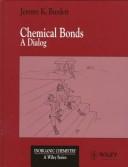
ISBN: 0471971308 0471971294 Year: 1997 Publisher: New York, NY : John Wiley,
Abstract | Keywords | Export | Availability | Bookmark
 Loading...
Loading...Choose an application
- Reference Manager
- EndNote
- RefWorks (Direct export to RefWorks)
Inorganic Chemistry This series reflects the breadth of modern research in inorganic chemistry and fulfils the need for advanced texts. The series covers the whole range of inorganic and physical chemistry, solid state chemistry, coordination chemistry, main group chemistry and bioinorganic chemistry. Chemical Bonds A Dialog Jeremy K. Burdett The University of Chicago, USA Understanding the nature of the chemical bond is the key to understanding all chemistry, be it inorganic, physical, organic or biochemistry. In the form of a question and answer tutorial the fundamental concepts of chemical bonding are explored. These range from the nature of the chemical bond, via the regular hexagonal structure of benzene and the meaning of the term 'metallic bond', to d-orbital involvement in hypervalent compounds and the structure of N_2O. Chemical Bonds: A Dialog provides* a novel format in terms of a dialog between two scientists* insights into many key questions concerning chemical bonds* an orbital approach to quantum chemistry
Chemical structure --- fysicochemie --- Chemical bonds. Valence --- 541.57 --- #WSCH:AAS2 --- Bonds --- Chemical bonds. --- 541.57 Bonds --- Chemical bonds --- Bonds, Chemical --- Chemistry, Physical and theoretical --- Overlap integral --- Quantum chemistry --- Valence (Theoretical chemistry) --- Molecular orbitals. --- Bond
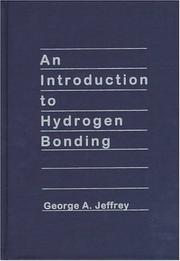
ISBN: 0195095499 0195095480 9780195095494 Year: 1997 Publisher: New York (N.Y.) : Oxford university press,
Abstract | Keywords | Export | Availability | Bookmark
 Loading...
Loading...Choose an application
- Reference Manager
- EndNote
- RefWorks (Direct export to RefWorks)
Hydrogen bonds range from the very strong, comparable with covalent bonds, to the very weak, comparable with van der Waals forces. Most hydrogen bonds are weak attractions with a binding strength about one-tenth of that of a normal covalent bond. Nevertheless, they are very important. Without them, all wooden structures would collapse, cement would crumble, oceans would vaporize, and all living things would disintegrate into inanimate matter. An easy-to-read supplement to the often brief descriptions of hydrogen bonding found in most undergraduate chemistry and molecular biology textbooks, An Introduction to Hydrogen Bonding describes and discusses the current ideas concerning hydrogen bonding, ranging from the very strong to the very weak, with introductions to the experimental and theoretical methods involved. Ideal for courses in chemistry and biochemistry, it will also be useful for structural biology and crystallography courses. For students and researchers interested in supramolecular chemistry, biological structure and recognition, and other sophisticated concepts and methodologies, it provides a careful selection of key references from the vast hydrogen bonding literature.
fysicochemie --- Chemical bonds. Valence --- Hydrogen bonding --- Hydrogen bonding. --- Hydrogen bonds --- Chemistry, Physical and theoretical --- Molecular association
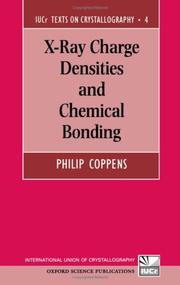
ISBN: 0195098234 Year: 1997 Publisher: Oxford Oxford University Press
Abstract | Keywords | Export | Availability | Bookmark
 Loading...
Loading...Choose an application
- Reference Manager
- EndNote
- RefWorks (Direct export to RefWorks)
Cristall chemistry --- fysicochemie --- Crystal chemistry --- Chemical bonds. --- Electron distribution --- X-ray crystallography
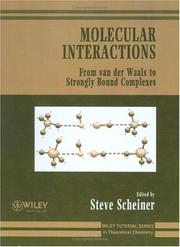
ISBN: 0471971545 Year: 1997 Publisher: Chichester ; New York : Wiley,
Abstract | Keywords | Export | Availability | Bookmark
 Loading...
Loading...Choose an application
- Reference Manager
- EndNote
- RefWorks (Direct export to RefWorks)
fysicochemie --- Chemical bonds. Valence --- Molecular association. --- Molecular dynamics. --- Association moléculaire --- Dynamique moléculaire --- 544.14 --- Molecular association --- Molecular dynamics --- #WSCH:AAS2 --- Dynamics, Molecular --- Dynamics --- Chemical bonds --- Bonding, chemical --- Association moléculaire --- Dynamique moléculaire
Periodical
Abstract | Keywords | Export | Availability | Bookmark
 Loading...
Loading...Choose an application
- Reference Manager
- EndNote
- RefWorks (Direct export to RefWorks)
Chemistry, Physical and theoretical --- Chemistry --- Electronics --- Research --- 35.11 quantum chemistry, chemical bonds --- Chimie physique et théorique
Book
ISSN: 09982365. ISBN: 2225855269 9782225855269 Year: 1997 Publisher: Paris: Masson,
Abstract | Keywords | Export | Availability | Bookmark
 Loading...
Loading...Choose an application
- Reference Manager
- EndNote
- RefWorks (Direct export to RefWorks)
Symétrie (Physique). --- Groupes (Théorie des. --- Chimie --- Groupes (Théorie des). --- Symétrie (Physique). --- Groupes (Théorie des. --- Groupes (Théorie des). --- Symétrie (physique) --- Groupes, Théorie des. --- Chemical bonds. --- Group theory. --- Molécules --- Chemical structure --- Symmetry (physics)

ISBN: 0197560873 1280528117 9786610528110 0195356942 1429414618 9780195356946 9780195098235 0195098234 Year: 1997 Publisher: [Chester, England] : New York : International Union of Crystallography ; Oxford ; Oxford University Press,
Abstract | Keywords | Export | Availability | Bookmark
 Loading...
Loading...Choose an application
- Reference Manager
- EndNote
- RefWorks (Direct export to RefWorks)
This book deals with the electron density distribution in molecules and solids as obtained experimentally by X-ray diffraction. It is a comprehensive treatment of the methods involved, and the interpretation of the experimental results in terms of chemical bonding and intermolecular interactions. Inorganic and organic solids as well as metals are covered in the chapters dealing with specific systems.
X-ray crystallography. --- Chemical bonds. --- Electron distribution. --- Density, Electron --- Distribution, Electron --- Electron density --- Electrons --- Bonds, Chemical --- Chemical structure --- Chemistry, Physical and theoretical --- Overlap integral --- Quantum chemistry --- Valence (Theoretical chemistry) --- Crystallography
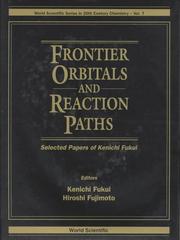
ISBN: 128195568X 9786611955687 9812795847 9789812795847 9810222416 9789810222413 6611955682 9781281955685 Year: 1997 Publisher: Singapore ; River Edge, N.J. : World Scientific,
Abstract | Keywords | Export | Availability | Bookmark
 Loading...
Loading...Choose an application
- Reference Manager
- EndNote
- RefWorks (Direct export to RefWorks)
This book is a collection of selected papers on the Frontier Orbital Theory by Nobel prizewinner Kenichi Fukui (Chemistry 1981), with introductory notes. It provides the basic concept and formulation of the theory, and the physical and chemical significance of the frontier orbital interactions in chemistry, together with many practical applications. The formulation of the Intrinsic Reaction Coordinate and applications to some simple systems are also presented. The aim of this volume is to show by what forces chemical reactions are driven and to demonstrate how the regio- and stereo-selectivities are determined in chemical reactions. Students and senior investigators will gain insight into the nature of chemical reactions and find out how quantum chemical calculations are connected with chemical intuition.
Molecular orbitals. --- Chemical reactions. --- Physical organic chemistry. --- Chemistry, Physical organic --- Chemistry, Organic --- Chemistry, Physical and theoretical --- Reactions, Chemical --- Chemical processes --- Orbitals, Molecular --- Chemical bonds --- Electrons --- Molecules --- Overlap integral --- Quantum chemistry --- Valence (Theoretical chemistry) --- Wave mechanics
| Listing 1 - 9 of 9 |
Sort by
|

 Search
Search Feedback
Feedback About UniCat
About UniCat  Help
Help News
News